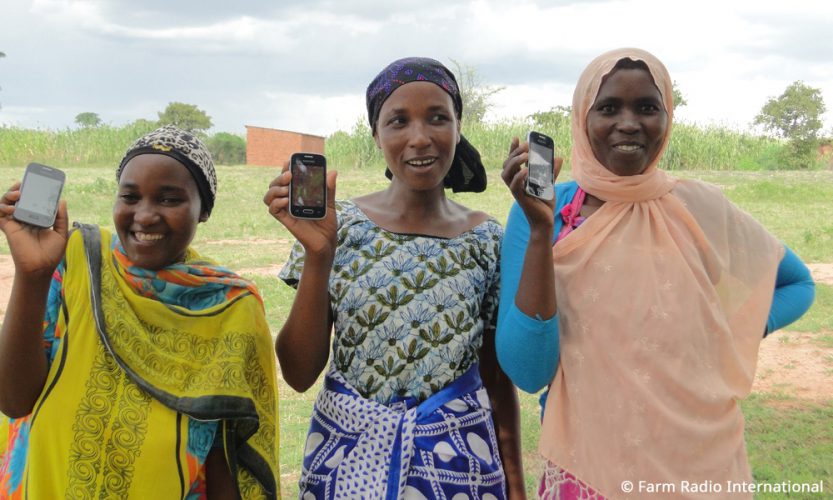As the United Nations launches the Decade of Family Farming, a spotlight is drawn to the role of family farmers in feeding themselves and their communities, stewarding environmental protection, and shepherding rural development. Rural people cannot do this work alone or unsupported, and communication is a unifying force – from radio and mobile phones, to mobile applications, websites, videos, and more. For the past few months we have been collecting stories about communication for development in rural Africa. Here are some of the best of these stories:
Five fascinating ways communication is supporting farmers
- Strengthening national agriculture systems in hard-to-reach places
Farmers can often feel cut-off from many government services, including agricultural extension systems. Some places are hard to reach by car, but those places are still accessible by the airwaves. Radio is an excellent way to serve rural communities with information they need to make good decisions about their lives and livelihoods, including weather information, crop prices, and pest management practices. Learn more about how Farm Radio International is using radio to encourage farmers to adopt new agricultural practices: http://yenkasa.wpengine.com/growing-community-conservation-agriculture-over-the-airwaves/
Radio can be broadcast live or recorded into MP3 podcasts . Read about how Practical Action has supported development agents to record podcast episodes: http://yenkasa.wpengine.com/mp3-recordings-bring-farm-tips-in-languages-farmers-in-rural-areas-understand/
Literacy Bridge Ghana has developed a low-cost, battery-operated audio computer, called the Talking Book, to educate farmers on a variety of agricultural practices. Learn more about their technology: http://yenkasa.wpengine.com/using-the-talking-book-to-amplify-and-widen-the-reach-of-extension-education-in-underserved-rural-communities/
Mobile phones, mobile apps, artificial intelligence – technology is evolving faster than ever before. Meanwhile, agriculture is thousands of years old. But by taking advantage of information and communication technologies (ICTs), agricultural extension systems can be more dynamic, more responsive, and more effective. The Canadian International Food Security Research Fund (CIFSRF), funded by the International Development Research Centre (IDRC) and Global Affairs Canada, tested several approaches to delivering useful agronomic advice to rural farmers through different ICT-supported extension models. Read about what they learned: http://yenkasa.wpengine.com/lessons-learnt-on-using-icts-to-scale-agricultural-innovations/
- Amplifying the opinions of farmers & starting a discussion
In the Decade of Family Farming, it is important to hear from farmers to understand their challenges, needs, and opinions. But with billions of people living in far-flung regions around the world, many of which are not connected to the World Wide Web, how do you make this possible? Radio.
Radio is known for its ability to share messages – or music! – across vast areas, traveling farther and faster than roads. Combined with mobile phones, radio is a great way to listen to rural populations. Farm Radio International’s Listening post format encourages listeners to participate in poll questions that are designed to garner real-time, unfiltered feedback from large audiences, which can be shared with decision-makers. Learn more: http://yenkasa.wpengine.com/the-listening-post-consulting-with-farmers/
Radio can also contribute to dialogue and understanding – or contribute to social and ethnic tensions. The Kenyan Community Radio Network (KCOMNET) is encouraging the former with their Umoja – Radio for Peace project. Learn more about the impact they are having: http://yenkasa.wpengine.com/community-radio-stations-unite-to-build-peace-part-1/
- Responding to urgent needs
When the Fall armyworm arrived in Africa in 2016, farmers were not aware of this invasive caterpillar or how to manage this voracious eater. Researchers, farmers, policymakers, and more feared that maize harvests would be destroyed.
The FAO’s farmer Field School approach let farmers in Uganda take the lead on collecting data about the spread of Fall armyworm, which was shared through the Fall Armyworm Early Warning System. Read more about how radio supported this work: http://yenkasa.wpengine.com/fao-uses-radio-and-farmer-field-school-approach-to-support-farmers-facing-the-fall-armyworm/
CABI (Centre for Agriculture and Biosciences International) had already planned village-based video screenings in Ghana to share information about soybeans, and so they developed three films on Fall armyworm that they could add to these planned activities. Learn more about the reach of these videos: http://yenkasa.wpengine.com/cabi-films-fight-fall-armyworm/
In Ethiopia, the Feed the Future Developing Local Extension Capacity project is bringing together many actors and many communication tools to create a demand-driven, timely, and responsive pest management system. Read about how they have leveraged video, IVR, mobile phones, and mobile apps: http://yenkasa.wpengine.com/combatting-fall-armyworm-in-ethiopia/
- Bringing value chain actors together
From farm to plate, it takes many people to grow, transport, process, market, cook, and feed the world. Farmers’ Corner Community is trying to bring together different agribusiness actors within Nigeria with an online community platform to fill the communication gap. Learn more about their work: http://yenkasa.wpengine.com/a-communication-platform-to-boost-production-and-sale-of-farm-produce/
- Encouraging youth in agriculture
Farming may be a solution to high youth unemployment and migration to urban centres, but many youth lack the skills, knowledge, finance, or network to start a farming business. In Cameroon, Radio Medumba is inspiring youth in agriculture by sharing the experience of one group of youth who recently started farming. Read their story: http://yenkasa.wpengine.com/a-parliamentarian-boosts-youth-engagement-in-agriculture-through-radio/
Have your own ideas about how communication can be used in the Decade of Family Farming? Join us in our Facebook group or submit your own story.


Permalink
SD Cards For Evangelizing
Jesus told this story: A farmer planted seed. Some fell along the road…some fell on rocky soil…some fell among bushes…some fell on good ground and they came up and produced a hundred times as much as was planted. His disciples asked Him what the story meant. Jesus answered “The Seed is God’s Word” Luke 8 “I planted the seed, Apollos watered it but God made it grow.” I Cor. You plant the seed, others will water it and God will make it grow. God has provided SD cards for sowing. We must sow.
SD cards can be loaded with Bible data and/or videos. They can be reproduced using a computer or SD copier.
They can be played in:
1. cellphones: audio only.
2. smart cellphones: audio/video.
3. computers: audio/video
Solar powered player manufacturers:
1. megavoice.com
2. renewoutreach.org/product/papyrus-solar-powered-audio-bible [used by SIBI].
USA: SanDisk charges $3 for blank SD card [8 GB].. They can be mailed worldwide [letter] for $1.15.
In a few weeks, I hope to have a SD card with the Jesus video and Bible studies.
Ken Hargesheimer, [email protected]